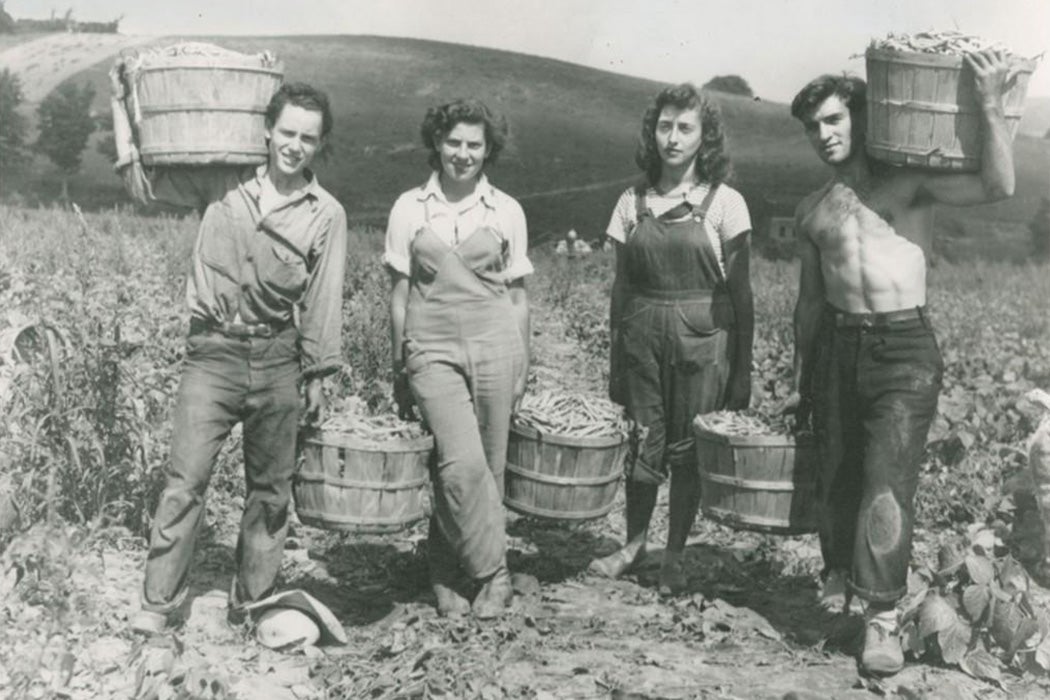The coronavirus pandemic wreaked havoc on agriculture during the 2020 growing season. Many farm workers are seasonal laborers who travel to pick crops as they are ready for harvest. But this year, some were afraid to leave home while others couldn’t travel get places due to travel restrictions or cancelled flights. A shortage of farm workers right when it was time to pick the crops meant struggling farmers had to fall back on high school students, school bus drivers, and other people to gather their harvest.
It wasn’t the first time in US history that students donned overalls and ventured into the fields to save the season’s harvest and put food on people’s tables. During World War II when many men were drafted, the country also suffered from a shortage of agricultural workers. While they were saving the world from fascism, students were saving the harvest back home.
That history is vividly documented in the black-and white photos and timeworn newspaper clippings of the Brooklyn College Farm Labor Project, which was recently digitized and made available on JSTOR. In 1942, Brooklyn College, along with several other city universities began to recruit students to work at farms in upstate New York, picking fruits and vegetables. For the next three years, over 300 students traveled, lived, and worked at the upstate farms in Red Hook and Morrisville, while also taking classes at night.
“Callouses and solid economic principles are being acquired by the 200 Brooklyn College students at work at the school’s farm project in Morrisville, NY,” wrote one newspaper at the time. It also noted that students were becoming “penny-pinchers,” developing newfound appreciation for the 50 cents they were paid for picking a bushel of peas or beans and calculating how many bushels an ice-cream or a movie ticket was worth. In addition to money, they also earned six academic credits for classes they took in the evening, after toiling in the field during the day. Other articles spoke about Brooklyn College biomedical students planting early peas in their Victory Gardens and taking lessons in transplanting.

The photos often portrayed the students as smiling and happy, but the reality was harsher, says Marianne LaBatto, associate archivist at the Brooklyn College Library. “They had to take classes at night after working in the field for a day. For young people who grew up in the city, being a college student by night and a farmer by day wasn’t easy, as one Brooklyn College paper noted. “While a great proportion of our students in Brooklyn are accustomed to working and taking classes at the same time, at Morrisville the long hours of manual labor in the open air, followed by one hour and a half of classroom in the evening constituted a completely new regimen that required many adjustments… that sometimes strained the city dweller’s capacity.”
While the photos often depict men and women, the majority of students were female, says LaBatto—because men were serving in the army. “Most men were off fighting and most of the farm labor were women because the majority of students at Brooklyn College during war years were women.”
Weekly Newsletter
There were other hardships too. Some students felt that they were being used as cheap labor, being paid 17 cents an hour to weed the fields. “We feel that we are important and are helping the war effort,” said one girl, “but we wish there were a freer market.”
The students’ work was indeed very important. If it wasn’t for their efforts, some crops would not have been picked and that food would likely have gone to waste, rather than the tables. Instead, it went on to feed the hungry population. In 1943 alone, the students picked over 700,000 pounds of peas and beans that fed New York City residents or soldiers, all the while the students kept studying geology, sociology, political science, math and English.
Support JSTOR Daily! Join our new membership program on Patreon today.







